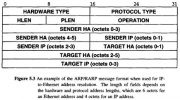Address Resolution Protocol (ARP)
From Computing and Software Wiki
Address Resolution Protocol is a low level protocol on the physical layer of the network with the purpose of finding other hosts Ethernet (hardware) addresses with their internet protocol (IP) addresses.
For programs to send information between computers over a network ARP will gather the IP to hardware address bindings so that other programs can use the hardware address to directly send to the specific hardware of the other host.
Contents |
Cache
ARP fills a cache with IP to physical address bindings by sending out broadcast messages of an ARP request type with a target hosts IP address asking for its physical address and at the same time giving its own IP to physical address binding. A cache is used since broadcasting ARP requests repeatedly for the same bindings is too expensive for all the hosts on the network to have to process.
The ARP cache contents can become invalid at any time without warning possibly because of hardware failure, also known as soft stated. The cache will generally have a timeout of about 20 minutes to clear out the IP to physical address bindings and will refill it with the same ones if needed which can allow for updating new physical addresses for certain IP addresses because of new hardware.
Implementation
ARP messages are carried in physical frames either as replies or requests for the 32 bit IP address to 48 bit physical address bindings.
Problems with ARP requests can arise when the target host is down or busy because it’s reply will be delayed. Ethernet is a best effort delivery, which requires retransmission after increasing delays of no replies since the original request possibly did not make it to the host. The ARP request will also contain the binding of the host sending it, so that the receiver of the request will be able to record in its own cache. The original sender will decide to wait for a reply to continue processing or not, save the binding of the requested host when it does receive a reply and can then use the physical address to directly send internet packets directly.
The receiver will decide whether or not its own IP address matches the contents of the ARP request and if so will send a reply back to the original sender with its own IP to physical address and add or update the binding of the requesting host to its own cache.
ARP format
ARP packets will have varying address field lengths depending on the type of network, but the header will contain fixed fields for specifying the lengths of the addresses. The figure on the right shows an ARP/RARP message format example with fields:Hardware Type is the interface type such as 1 for Ethernet.
Protocol Type is the high-level protocol address such as an IP address from the sender.
HLEN and PLEN contain the lengths of the hardware and IP addresses.
Sender IP/HA or Target IP/HA contain the IP and hardware addresses that are known.
ARP Vulnerabilities
ARP requests and replies are vulnerable to forgery also known as ARP Poisoning with the purpose of redirecting traffic of packets. There is no check for valid ARP replies or requests so it is possible to forge either to force a host to update its cache since the host would be assuming that the previous entry is now invalid because of a hardware failure on the host.
See Also
References
1.Douglas Comer, Internetworking with TCP-IP, Published by Prentice-Hall International, 2001
2. An Ethernet ARP, November 1982
3. Address Resolution Protocol, Jörg Liebeherr’s Lecture
External Links
http://en.wikipedia.org/wiki/Address_Resolution_Protocol
http://www.networksorcery.com/enp/protocol/arp.htm
http://www.erg.abdn.ac.uk/users/gorry/course/inet-pages/arp.html
--Boudra 15:47, 12 April 2009 (EDT)

